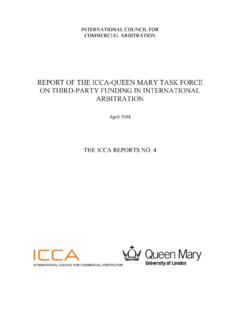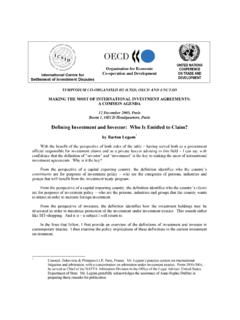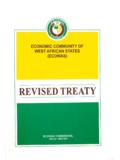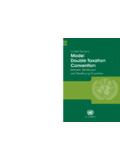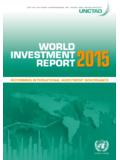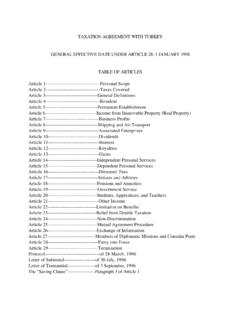Transcription of ICSID VERSUS NON-ICSID INVESTMENT TREATY …
1 VERSUS NON- ICSID INVESTMENT TREATY ARBITRATIONBy Piero BERNARDINI I. Introduction. II. ICSID and non- ICSID arbitration: differences of a generalnature. III. ICSID and non- ICSID arbitration: specific differences. a) Independence ofthe arbitrator; b) The Tribunal s jurisdiction; c) The arbitral proceeding; d) The challengeof the award; e) The enforcement of the award. IV. Concluding INTRODUCTION1. Bernardo Cremades, to whom this paper is dedicated, has been and still is extensivelyinvolved in INVESTMENT TREATY arbitration. The subject of this contribution seems therefore tomatch well one of Bernardo s fields of professional According to a qualified source, at the end of 2007 the cumulative number of knowninvestment TREATY arbitration cases reached 2901. 73 States were involved, 44 of developingcountries, 15 of developed countries and 14 of South-East Europe and the Commonwealthof Independent State (CIS).
2 Argentina ranked first with 46 claims, followed by Mexico with18 and the Czech Republic with 142. The same source indicates that the great majority ofthese cases (78%) were initiated on grounds of violation of a bilateral INVESTMENT TREATY (BIT), followed by the North American Free Trade Agreement (NAFTA) (13%) and theEnergy Charter TREATY (6%), with two cases initiated on grounds of violation of the CentralAmerican Dominican Republic United States Free Trade Agreement3. In 2008 knowntreaty-based investor-state dispute settlement cases have reached the number of 317, out ofwhich 201 were filed with ICSID (or the ICSID Additional Facility), 83 under the Vice-President, Italian Arbitration Association; past Vice-President, ICC International Court of Arbitration;Of Counsel, Ughi & Nunziante, United Nations Conference on Trade and Development (UNCTAD), Latest development in investor Statedispute Settlement, ILA Monitor, N 1 (2008), International INVESTMENT Agreements,UNCTAD/WEB/ITE/IIA/2008/3, The number of cases mentioned in the text does not include thoseexclusively based on INVESTMENT contracts (ibidem, footnote 1).
3 2 Ibidem, p. Rules, 17 with the Stockholm Chamber of Commerce ( SCC ), five with theInternational Chamber of Commerce ( ICC ) and five were ad BITs, NAFTA, Energy Charter TREATY and other INVESTMENT protection treaties offer toinvestors, as a rule, more than one alternative method of arbitration. Those most commonlyreferred to are the following: the ICSID Convention; the ICSID Additional Facility Rules;the UNCITRAL Arbitration Rules of 1976 ( UNCITRAL Rules ); the Rules of Arbitrationof the ICC of 1998 ( ICC Rules ); the LCIA Arbitration Rules of 1998 ( LCIA Rules ); theArbitration Rules of the Arbitration Institute of the SCC of 2007 ( SCC Rules ).4. While BITs differ regarding offered methods of dispute settlement, the NAFTA and theEnergy Charter TREATY identify specific 1120 in the NAFTA s Chapter 11 on Investments provides: 1.
4 Except as provided in Annex , and provided that six months haveelapsed since the events giving rise to a claim, a disputing investor may submitthe claim to arbitration under:(a) the ICSID Convention, provided that both the disputing Party and the Partyof the investor are parties to the Convention;(b) the Additional Facility Rules of ICSID , provided that either the disputingParty or the Party of the investor, but not both, is a party to the ICSIDC onvention; or(c) the UNCITRAL Arbitration Rules. Article 26(4) of the Energy Charter TREATY provides: (4) In the event that an Investor chooses to submit the dispute for resolutionunder subparagraph 2(c), the Investor shall further provide its consent in writingfor the dispute to be submitted to:(a) (i) the International Centre for Settlement of INVESTMENT Disputes,established pursuant to the Convention on the Settlement of InvestmentDisputes between States and National of other States opened forsignature at Washington, 18 March 1965 (hereinafter referred to as the ICSID Convention ), if the Contracting Party of the Investor and theContracting Party party to the dispute are both parties to the ICSIDC onvention; or 4 UNCTAD, ILA Monitor N 1 (2009), p.
5 (ii) The International Centre for Settlement of INVESTMENT Disputes,established pursuant to the Convention referred to in subparagraph (a)(i),under the rules governing the Additional Facility for the Administrationof Proceedings by the Secretariat of the Centre (hereinafter referred to asthe Additional Facilities Rules ), if the Contracting Party of theInvestor or the Contracting Party party to the dispute, but not both, is aparty to the ICSID Convention;(b) a sole arbitrator or ad hoc arbitration tribunal established under theArbitration Rules of the United Nations Commission on InternationalTrade Law (hereinafter referred to as UNCITRAL ); or(c) an arbitral proceedings under the Arbitration Institute of the StockholmChamber of Commerce. 5. Out of the 290 INVESTMENT TREATY arbitration cases, 182 were filed with ICSID , includingICSID Additional Facility Rules (62%), 80 under the UNCITRAL Rules (28%), 14 underthe SCC Rules (5%), 5 under the ICC Rules (2%) and 5 under ad hoc arbitration (2%) andfew others in unknown fora (1%) attempt to analyse the reasons for the investor s choice of a given method of disputesettlement among those alternatively offered by a BIT or a multilateral INVESTMENT TREATY (such as the NAFTA or the Energy Charter TREATY ) may assist in identifying trends in thesearch for better INVESTMENT protection through arbitration and possible grounds ofdissatisfaction (or merely preference)
6 For one specific method of dispute many cases, the choice of non- ICSID arbitration is due to the circumstance that one of theStates involved is not a party to the ICSID However, there are cases whereeither the investor or the State has chosen a method of arbitration other than the ICSIDC onvention, although the latter was available to it7. 5 Ibidem, pages In the case of Canada and Mexico regarding disputes under NAFTA or of the Federation of Russiaregarding disputes under BITs to which it is party. On March 14, 2008 Canada passed legislation enabling itto ratify the ICSID Convention; however, such ratification has not yet been In the case of the arbitration proceeding between National Grid v. The Argentina Republic, based onthe BIT between United States and Argentina (both States being parties to the ICSID Convention), theinvestor has opted for the UNCITRAL Rules.
7 In the case of the arbitration proceeding between AWG GroupLtd v The Argentina Republic, based on the BIT between the United Kingdom and Argentina (both Statesbeing parties to the ICSID Convention), Argentina did not agree to extend ICSID jurisdiction to the claims ofAWG, thus making applicable UNCITRAL Rules but accepting ICSID administration of the case (Decision4 The inquiry into the reasons for investors choice cannot but be based on the review of theessential features of each method of arbitration and the respective pros and cons. To thisend, the dispute settlement methods provided by INVESTMENT treaties may be convenientlygrouped in two categories, ICSID and non- ICSID , the former consisting of the ICSIDC onvention, the latter of all others (including ICSID Additional Facilities Rules).)
8 II. ICSID AND NON- ICSID ARBITRATION: DIFFERENCES OF A GENERAL NATURE6. The arbitration system under the ICSID Convention differs in many important respects fromthe other systems of arbitration, including the Additional Facility Rules. This differencebears both upon the rules governing the proceeding and those governing the challenge ofawards and their enforcement. In a recent contribution,8 the advantages to investors ofICSID arbitration have been summarised as follows: It provides investors with direct access to a form of settlement of a disputethey may have with a host State. It extends the possibility of dispute settlement beyond the realm of nationalcourts in the host State. Investors do not depend upon the willingness of their home State to exercisediplomatic protection on their behalf.
9 The enforcement provisions of the ICSID Convention make it highlyprobable that final ICSID awards will be effectively The mentioned advantages hardly make all the difference between ICSID and non- ICSID systems of arbitration that may be chosen by an investor under the applicable investmenttreaty. Also such other systems offer in fact a direct access to a settlement of disputes withthe host State with the effect of ousting national courts jurisdiction, without the need of thehome State s assistance through the exercise of diplomatic protection or otherwise, while theprobability of effective enforcement of ICSID awards is presently not so high as advantage of the ICSID Convention is rather the fact that the INVESTMENT dispute is on Jurisdiction of August 3, 2006 in the consolidated case Suez and others v.
10 Argentina and AWG , para. 4).8 Reinisch Malintoppi, Methods of Dispute Resolution, The Oxford Handbook of International InvestmentLaw, 2008, p. under the framework of an international TREATY , which accordingly is the only sourceof regulation of all aspects of the dispute9. The ICSID Convention provides in fact a self-contained system of arbitration, fully autonomous and independent of any national legalsystems, including the system prevailing at the place of an arbitration conducted under theConvention. This self-contained regulation covers all aspects of the arbitral proceedings andextends to the challenge of the awards, the latter being regulated only by the Convention,without any interference by national courts or other national authorities, no room for theapplication of the New York Convention being made regarding enforcement of an The State party to the dispute is bound to respect the obligations undertaken by it under theICSID Convention not only vis- -vis the State of the investor s nationality but also all otherState parties to the Convention.





